 Website:
KAYA YAPI IC MIMARLIK A.S.
Website:
KAYA YAPI IC MIMARLIK A.S.
Group: KAYA SAFETY
Catalog excerpts

WORKING AT HEIGHT AND RESCUE EQUIPMENT
Open the catalog to page 1
MEET MUSA It is an ordinary day for Musa at 26 meters above the ground. He is a fully certified Occupational Safety Training team leader. He has been a part of the Kaya Safety team for eight years and has trained over 5000 people during this time. Every day Musa spends a good deal of his time at heights that would make most people dizzy. And he does not do this alone... Like all of us, he carries his loved ones on his mind, in his heart, and often on his shoulders. His 4 year old son, Kuzey, and his wife, Duygu, are the main reason why he needs to go home every day, without a scratch. Musa...
Open the catalog to page 3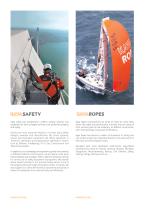
KAVASAFETV Kaya safety was established in 1996 to design systems and equipment for work at height activities to be performed properly and safely. Having the most advanced facility in its field, Kaya Safety designs, develops and manufactures fall arrest systems, rescue and evacuation equipment and lifting equipment in Turkey for institutions and organizations operating in sectors such as Defense, Firefighting, Oil & Gas, Construction and Telecommunication. In addition to our knowledge and experience gained from working in different fields for over 18 years, we are aware of the issue that...
Open the catalog to page 5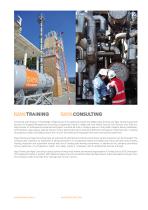
Combining with 30 years of knowledge of Kaya Group in Occupational Health and Safety; Kaya Training and Kaya Consulting provide solutions in Strategic Management Consulting, Occupational Health & Safety and Joint Health Security Unit Services since 2001 to a large number of multinational companies and projects in almost all cities in Turkey as well as in Iraq, Gabon, Nigeria, Russia, Kazakhstan, Turkmenistan, Libya, Algeria, Albania, Kosovo, Tunisia, Saudi Arabia, Syria, Ukraine and Morocco and plays an important role in creating Occupational Health and Safety culture with its over 40...
Open the catalog to page 6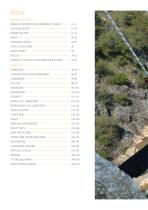
WORKING AT HEIGHT GENERAL PRINCIPLES OF WORKING AT HEIGHT 8-11 DIFFICULT TO REACH LOCATIONS (ROPE ACCESS) 32-33 LANYARDS AND SHOCK ABSORBERS- 56-77 MOBILE FALL ARRESTERS 118-123 RETRACTABLE FALL ARRESTERS 124-131 TRIPOD AND CANTILEVER ARMS - 168-187 ROCK PRODUCT GROUP - 244-273
Open the catalog to page 7
PRINCIPLES OF WORKING AT HEIGHT TRAINING Working at height is one of the biggest causes of workplace fatalities and major injuries. Employers must ensure that a sufficient risk assessment is carried out so that all risks of working at height are effectively identified, controlled and managed. Every employer must also ensure that employees are appropriately trained under careful and competent supervision to ensure that they can carry out their work safely. Please contact KAYA TRAINING division of our company for more information about working at height training programs. E-mail:...
Open the catalog to page 9
PRINCIPLES OF WORKING AT HEIGHT Restraint System allows workers to perform their task without the possibility of losing contact with the walking / working surface. 2. FALL ARREST SYSTEM (A) Fall Arrest System is designed to stop the free fall of a user and limit the maximum arresting forces imposed on the user to 6 kN or less. A fall arrest system provides maximum freedom of movement for workers to conduct their duties by connecting to the (A) safe attachment point.
Open the catalog to page 10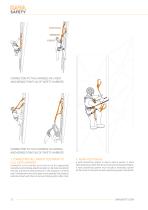
CONNECTION TO THE HARNESS VIA CHEST ANCHORAGE POINT (A) OF SAFETY HARNESS ÇİZİM 6 LANYARDIN SIRTTAN KULLANIMINDA DÜŞÜŞ CONNECTION TO THE HARNESS VIA DORSAL ANCHORAGE POINT (A) OF SAFETY HARNESS 3. CONNECTING FALL ARREST EQUIPMENT TO FULL BODY HARNESS Connection to the harness must only be via the appropriate connection points (dorsal attachment point or the chest connection) that will provide the best protection in the situation it is being used. Consideration should be given to the potential fall distance, potential impact with the structure and body position after a fall. A work...
Open the catalog to page 11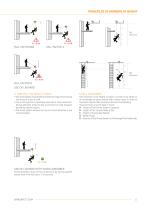
PRINCIPLES OF WORKING AT HEIGHT Fall Clearence Fall Clearence USE OF LANYARD 5. LIMITING THE IMPACT FORCE • Fall arrest system must limit the maximum impact force during the arrest of a fall to 6 KN. • Fall arrest system is generally used with a shock absorber. Energy absorber limits the fall arrest force in a fall situation by tearing specific seams. • Fall arrest system without the use of a shock absorber is not recommended. Fall clearance is the height at which a worker must attach to an anchorage to avoid contact with a lower level. In order to calculate required fall clearance distance...
Open the catalog to page 12
TELECOM SECTOR KMSAFETY 1. ASCENDING WITH VERTICAL LIFELINE MonopoLe or Lattice towers are widely used in telecommunication sector. The safest way to climb up and down these towers is to use permanent vertical lifeline system installed on ladder (if such ladder exist). User is connected to a vertical lifeline by a wire rope grab which is attached to the (A) chest attachment point of full body harness. When the user moves (up or down), it slides along the life line. In the event of a fall, the device stops the fall instantly on the cable. 2. ASCENDING WITH DOUBLE LEGGED SHOCK ABSORBING...
Open the catalog to page 14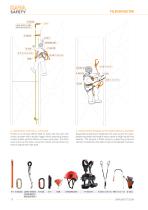
LUPA STATIC 11 MM LUPA STATİK WITH SPLICED EYE 11 MM GÖZLÜ 3. CREATING VERTICAL LIFELINE If there is no vertical lifeline fixed on tower, the first user who climbs up tower with a double-legged shock absorbing lanyard creates mobile vertical lifeline on tower using rope. The other users climb up the tower using this mobile vertical lifeline by help of appropriate rope grab. F-7 K-30/3A LUPA® STATIC 11 MM WITH SPLICED EYE 4. WORK POSITIONING WITH ADJUSTABLE LANYARD Adjustable lanyards are designed to be used as part of a work positioning system and enable users to work at height hands-free...
Open the catalog to page 15
ENERGY SECTOR LUPA LUPA STATİK STATIC 11 MM WITH 11 MM GÖZLÜ SPLICED EYE 1. ASCENDING WITH DOUBLE-LEGGED SHOCK ABSORBING LANYARD 2. CREATING VERTICAL LIFELINE WITH ROPE If there is no vertical lifeline fixed on energy towers then user uses the double-legged shock absorbing lanyard to move around the tower whilst being connected at all times. It is recommended to attach double-legged shock absorbing lanyard to the (A) chest attachment point of full body harness. Connection from chest anchorage point prevents a falling worker hitting from surface facing toward user. F-7 K-30/3A LUPA® STATIC...
Open the catalog to page 18All KAYA YAPI IC MIMARLIK A.S. catalogs and technical brochures
-
KAYA SAFETY 2020
114 Pages
-
LUPA STATIC 11
6 Pages
-
TURTLE
1 Pages
-
K-2010 A
1 Pages
-
Kaya Training & Consulting 2016
166 Pages
-
Kaya Ropes Leisure Marine 2016
104 Pages
-
Kaya Defence 2016
76 Pages
-
Kaya Adventure 2016
50 Pages
-
Kaya Safety
156 Pages
-
Kaya Ropes
75 Pages











